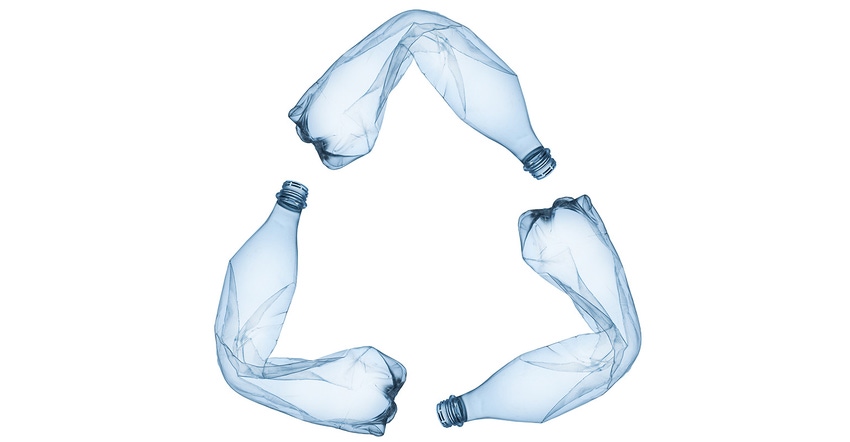Recycled PET Prices Trending Down Amid Weak US Demand
Current economic headwinds have led some buyers to delay or limit orders of higher cost recycled resin.
June 5, 2023

Paula Leardini
Demand for recycled polyethylene terephthalate (rPET) is expected to remain moderate to soft in 2023 despite long-term recycled content goals, resulting in potential downward price pressure in the United States.
To understand the US rPET market, one must look at the basics of each major price driver — supply, demand, production costs, and quality.
In terms of rPET supply, ICIS Mechanical Recycling Supply Tracker has identified nearly 120 mechanical recycling sites in the United States with a total capacity of 1.9 million tonnes in 2022.
Approximately 80% of US rPET capacity comes from post-consumer sources, primarily bottles, while the remaining 20% originates from post-industrial feedstock. Ten US states have bottle bill programs, also called deposit return schemes (DRS), to encourage container recycling.
In addition, nearly 50% of US rPET capacity is food grade, which is a requirement for recycled resins to be used in new beverage containers.
|
Mechanical PET recycling footprint in United States. |
Evolving state regulations and voluntary brand-owner pledges to increase the use of recycled materials are the main sustainability-related demand drivers in the United States in the long term.
Recycled content mandates
On Jan. 1, 2022, California’s minimum recycled content mandate for plastic beverage containers came into effect. The state of Washington and New Jersey have passed similar bills with recycled content mandates that start in 2023 and 2024, respectively, and include more product categories such as non-beverage containers, plastic carryout bags, and trash bags. Maine also passed a law requiring recycled content for plastic beverage containers starting in 2026.
Despite future requirements to use increasing amounts of recycled plastic, current rPET supply is healthy, borderline in excess, to meet today’s demand.
From bottle to pellet, recycling costs include the feedstock as well as other production expenses. The key difference between the recycled and virgin resin markets is feedstock source, as the recycling industry uses plastic waste, a volatile material in terms of quality, availability, and price. Furthermore, recycling production costs have risen in tandem with higher labor costs, electricity, and financing rates across the nation.
For recyclers, the challenge is to remain viable as a business but also competitive with virgin resin prices, which can cannibalize margins and even lead to production losses.
The quality of recycled resin influences both demand and price, depending on performance, color, and end markets. The US market has traditionally used bottle flake most significantly in fiber applications, but the bottle-to-bottle market has grown considerably in recent years, given the sustainability agenda of fast-moving consumer goods (FMCG). The demand for closed loop recycling in food-contact applications also drives up quality requirements in feedstock and recycled products. This increases prices for the highest quality clear PET bales and food-grade rPET.
Economic conditions weaken demand
US rPET demand traditionally was dominated by the fiber industry, but current economic headwinds affecting products such as the textile and carpet end markets have weakened demand throughout 2023.
Demand from consumer goods companies, including bottled beverage producers, is currently flat despite long-term recycled content goals.
While some consumer goods companies continue to purchase rPET to meet their voluntary or regulatory targets for recycled content, the current economic headwinds have led other buyers to delay or limit orders of higher-cost recycled resins.
The price of virgin resin still has an influence on demand for recycled materials among cost-sensitive buyers. When the delta between virgin and recycled feedstock expands in favor of virgin as the lower-cost feedstock, buyers can be drawn toward a higher mix of virgin resin. This has been evident in the market this year, as economically incentivized customers have shifted focus to managing costs rather than driving plastics circularity.
The combined market conditions have resulted in downward price pressure in the United States for most recycled resin grades. For instance, according to my colleague Emily Friedman, recycled plastics senior editor at ICIS, spot market color-less post-consumer rPET flake and pellet prices have dropped across the United States, reflecting continued demand weakness paired with pressure from competitive imports.
In the next couple of months, rPET demand is expected to remain soft, despite the historical expectation of peak bottled beverage demand during the summer season.
Although sustainability-driven US buyers are expected to maintain consistent demand for rPET, cost-sensitive buyers may switch back to higher volumes of virgin PET in their feedstock mix, especially as virgin PET prices drop because of ongoing destocking in the United States.
In the next couple of years, the market is expected to recover in response to regulatory and voluntary recycled content targets. The return of demand is expected to put upward pressure on rPET supply and, therefore, prices in the near term, until there is substantial expansion in supply.
About the author
Paula Leardini is a senior analyst and Americas analyst team lead for plastics recycling at ICIS, which helps businesses in the energy, chemicals, and fertilizer industries make strategic decisions, mitigate risk, improve productivity, and capitalize on new opportunities through a global team of more than 600 experts.
You May Also Like



